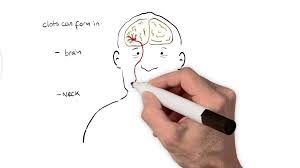What is a Stroke? Can I Recover?
NeuroRehab Team
Thursday, June 9th, 2016
NeuroplasticityStroke Statistics

A stroke is a “brain attack”. It occurs when blood flow to an area of brain is cut off. When this happens, brain cells are deprived of oxygen and begin to die. When brain cells die during a stroke, abilities controlled by that area of the brain such as memory and muscle control are lost.
Stroke can be caused either by a clot obstructing the flow of blood to the brain (called an ischemic stroke) or by a blood vessel rupturing and preventing blood flow to the brain (called a hemorrhagic stroke). A TIA(transient ischemic attack), or “mini stroke”, is caused by a temporary clot.
Below is a a simple animation explaining what a stroke is, how to recognize the key symptoms, how it is treated, and what we can all do to prevent strokes from happening.
To learn more about treatment options following a stroke, click on the below links for more information.
Arm Bike
An Arm Bike is a stationary cycle designed to strengthen and condition the upper body, as well as the cardiovascular system, by using the arms.
Biofeedback
Biofeedback or electromyography (EMG) is a non-invasive technique used for measuring muscle electrical activity that occurs during muscle contraction and relaxation.
Body Weight Support
Body Weight Support uses a suspension system and a harness to support a percentage of the user’s body weight during standing, walking or exercise.
Find Body Weight Support Devices
Cognitive-Communication Training
Cognitive-Communication Training consists of specialized hardware devices and/or software programs used in therapy or at home as a way to improve cognition and/or communication skills.
Find Cognitive-Communication Devices
Edema Management
Edema is a medical term for swelling caused by excess fluid trapped in the body’s tissues (i.e., hand/foot). One of the common treatment techniques used to reduce edema is a compression garment. Examples of garments include gloves, elastic stockings, and ace wraps.
Find Edema Management Products
Electrical Stimulation
Electrical stimulation or neuromuscular electrical stimulation (NMES) is a technique used to elicit a muscle contraction using electrical impulses. Electrical current is then sent from the unit to the electrodes and delivered into the muscle causing a contraction.
Find Electrical Stimulation Devices
EMG-Triggered Stimulation
EMG-Triggered Stimulation is based on the user’s voluntary movement, or intent to move. Electrodes, controlled by a unit, are placed on the skin over a specific area. Once the user attempts to contract his or her muscles and reaches the prescribed threshold, stimulation is triggered (delivered) to the same muscles. Various visual and auditory feedback options monitor the progress.
Find EMG-Triggered Stim Devices
Exercise Aid
An Exercise Aid is a piece of equipment used during physical activity to improve strength and coordination of the body region targeted.
Foot Drop Brace
A Foot Drop Brace is a rigid or flexible support that offers dynamic or static assistance to the weakened foot so functional mobility and exercises can be possible.
Hand Function Splint
A Hand Function Splint is a rigid or flexible brace that offers dynamic or static assistance to the weakened hand so functional activities and exercises can be possible.
Leg Bike
A Leg Bike is a stationary cycle designed to strengthen and condition the lower body, as well as the cardiovascular system, by using the legs.
Lower Limb Robot-Assisted Therapy
Lower Limb Robot-Assisted Therapy consists of an electromechanical device, designed for the leg, that is used to assist users (through powered mobility) with exercise training and activities of daily living (ADL).
Find Lower Limb Robot-Assisted Therapy
Mirror Therapy
In Mirror Therapy, a mirror is placed beside the unaffected limb, blocking the view of the affected limb. This creates the illusion that both limbs are functioning properly. Damaged areas of the brain’s motor cortex may improve by viewing movements of intact, functioning limbs.
Mobile Arm Support
A Mobile Arm Support (MAS) is a gravity supported mechanical device mounted on wheelchairs, tables, or base frames. A MAS is used to support the weak arm to improve motor function and strength. In addition, the device allows patients with shoulder weakness to perform self care tasks such as feeding, hygiene, grooming, and writing.
Motorized Arm and Leg Bike
A Motorized Arm and Leg Bike is a motor-assisted cycle designed to strengthen and condition the upper body and lower body, as well as the cardiovascular system, by only using the arms and/or legs.
Find Motorized Arm and Leg Bikes
Shoulder Subluxation Sling
A Subluxation Sling is typically used on hemiparetic arms that are flaccid or exhibit minimal to no movement. They offer support, protection against injury and can prevent or reduce shoulder pain.
Find Shoulder Subluxation Slings
Upper Limb Contracture Splint
A Upper Limb Contracture Splint is a brace used to prevent or treat contractures. The goal of a contracture splint is to help keep the soft tissues (muscle and tendons) in the arm and hand stretched properly.
Find Upper Limb Contracture Splints
Upper Limb Robot-Assisted Therapy
Upper Limb Robot-Assisted Therapy consists of an electromechanical device, designed for the arm or hand, that is used to assist users (through powered mobility) with exercise training and activities of daily living (ADL).
Find Upper Limb Robot-Assisted Therapy
Virtual Reality/Exercise Games
Virtual Reality/Exercise Games consists of computer-based, interactive exercise games and activities that allow players to engage in entertaining tasks while being physically challenged. These games rely on technology that tracks body movements or reactions. Some advanced games allow users to set goals, grade and customize, receive instantaneous feedback, reinforce behaviors, and record and analyze results.
Find Virtual Reality/Exercise Gaming Devices
Visual Motor Training
Visual Motor Training consists of coordinating visual skills together with gross-motor and/or fine-motor movement. It is the ability to integrate visual input with physical output. This is how individuals plan, execute and monitor functional tasks, such as turning a page, buttoning a shirt, or walking safely.
Find Visual Motor Training Devices

